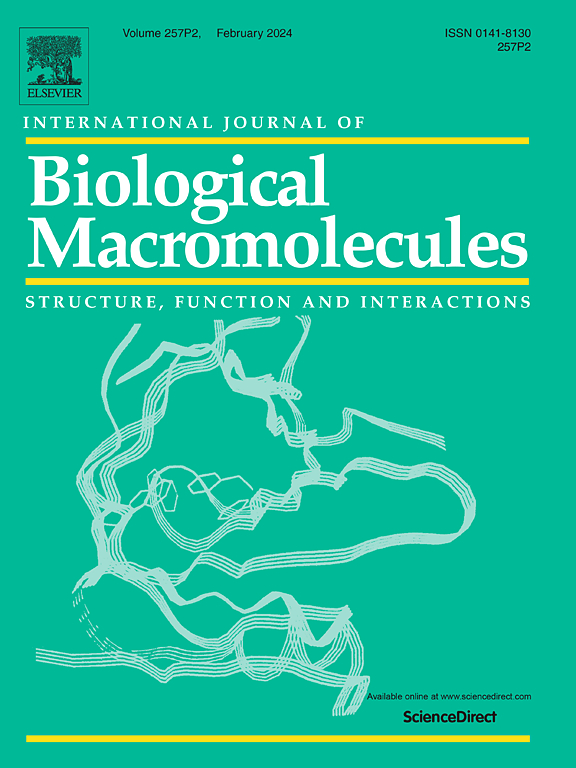Significant enhancement of the thermal stability and catalytic efficiency of transglutaminase in Streptomyces mobaraensis engineered through the novel S. mobaraensis genomic mutant library construction method GHR/Sml
IF 7.7
1区 化学
Q1 BIOCHEMISTRY & MOLECULAR BIOLOGY
International Journal of Biological Macromolecules
Pub Date : 2024-11-17
DOI:10.1016/j.ijbiomac.2024.137733
引用次数: 0
Abstract
Herein, we developed a novel Streptomyces mobaraensis genomic mutant library construction method, GHR/Sml, to directly and significantly enhance the thermal stability and catalytic efficiency of TGase in the genome of S. mobaraensis. First, 13 key amino acid residues and their mutations for enhanced thermal stability were identified using error-prone PCR and site-directed mutagenesis. Then, the GHR/Sml method was developed to construct a TGase genomic mutant library with 13 mutations. Positive mutants S23Y/Y24N/S250R, S23Y/Y24N/S303K, S23Y/Y24N/K294L, S23Y/Y24N/S199A/R208L, S23Y/Y24N, and S250R were obtained from 1500 total mutants; their half-life values at 50 °C were increased by 9.3-, 9.5-, 8.7-, 9.0-, 6.9-, and 4.8-fold compared with that of TGLD, respectively. Furthermore, the kcat/Km of mutant S23Y/Y24N/S250R increased by 1.25-fold over that of TGLD. The activity of S23Y/Y24N/S250R reached 65.34 U/mL in a 1000-L fermenter, which was the highest activity reported. This novel GHR/Sml method is of great significance for systematically improving properties of additional enzymes in the genome of S. mobaraensis.
通过新型 S. mobaraensis 基因组突变体文库构建方法 GHR/Sml,显著提高了莫巴拉链霉菌转谷氨酰胺酶的热稳定性和催化效率。
在此,我们开发了一种新型的莫巴拉链霉菌基因组突变体文库构建方法--GHR/Sml,以直接显著地提高莫巴拉链霉菌基因组中TG酶的热稳定性和催化效率。首先,利用易错 PCR 和定点突变技术确定了 13 个可增强热稳定性的关键氨基酸残基及其突变。然后,开发了 GHR/Sml 方法来构建具有 13 个突变的 TGase 基因组突变体文库。从 1500 个突变体中获得了阳性突变体 S23Y/Y24N/S250R、S23Y/Y24N/S303K、S23Y/Y24N/K294L、S23Y/Y24N/S199A/R208L、S23Y/Y24N 和 S250R;与 TGLD 相比,它们在 50 °C 的半衰期值分别增加了 9.3、9.5、8.7、9.0、6.9 和 4.8 倍。此外,突变体 S23Y/Y24N/S250R 的 kcat/Km 比 TGLD 增加了 1.25 倍。在 1000 升发酵罐中,S23Y/Y24N/S250R 的活性达到 65.34 U/mL,是目前报道的最高活性。这种新颖的 GHR/Sml 方法对于系统地改进 S. mobaraensis 基因组中其他酶的特性具有重要意义。
本文章由计算机程序翻译,如有差异,请以英文原文为准。
求助全文
约1分钟内获得全文
求助全文
来源期刊
CiteScore
13.70
自引率
9.80%
发文量
2728
审稿时长
64 days
期刊介绍:
The International Journal of Biological Macromolecules is a well-established international journal dedicated to research on the chemical and biological aspects of natural macromolecules. Focusing on proteins, macromolecular carbohydrates, glycoproteins, proteoglycans, lignins, biological poly-acids, and nucleic acids, the journal presents the latest findings in molecular structure, properties, biological activities, interactions, modifications, and functional properties. Papers must offer new and novel insights, encompassing related model systems, structural conformational studies, theoretical developments, and analytical techniques. Each paper is required to primarily focus on at least one named biological macromolecule, reflected in the title, abstract, and text.

 求助内容:
求助内容: 应助结果提醒方式:
应助结果提醒方式:


